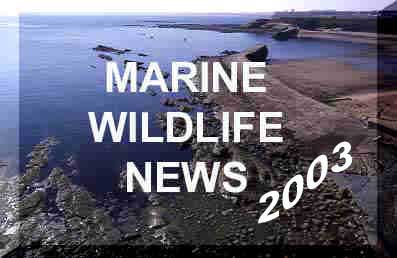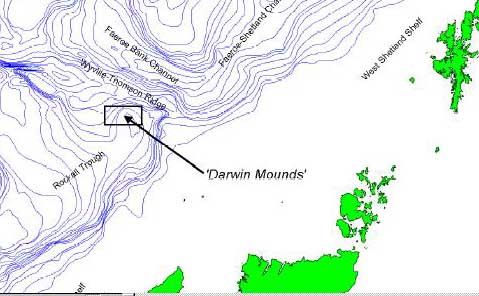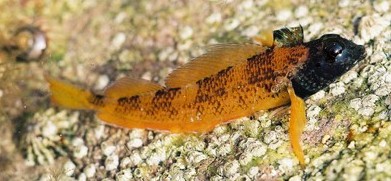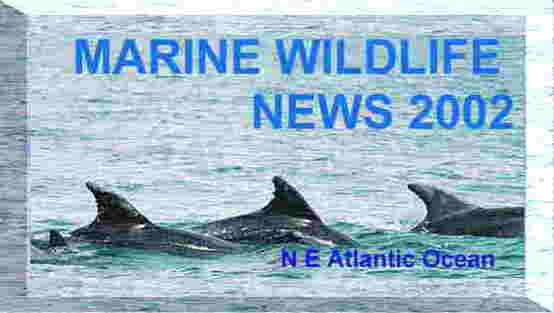
|
|
|
|
|
(BMLSS *** Site) |
|
|
|
Norwegian Marine*** |
|
L-I-N-K-S to Other Sites (Click on Text) |
|
Smart Group |
 |
|
|
|
|
|
|
 .
.
Reports of marine wildlife from all around the British Isles, with pollution incidents and conservation initiatives as they affect the fauna and flora of the NE Atlantic Ocean.
on Microsoft Internet Explorer (best) or Netscape
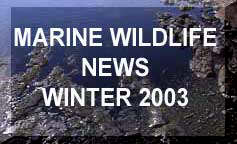 |
 |
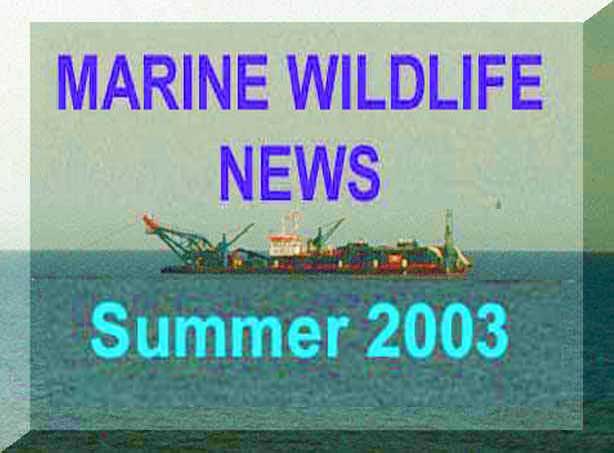 |
 |
LATEST NEWS: SUMMER 2003
29 September 2003
A large whale, initially identified as a Minke Whale, Balaenoptera acutorostrata, was reported floating 8 km west of Hoek van Holland. Subsequently, it was decided to tow the whale out of the way. However, after an analysis of several photographs by Kees Camphuysen, the whale was identified as a Humpback Whale, Megaptera novaengliae. This the first record of this species in The Netherlands!
Three ImagesReport by Jan Wouter on UK Cetnet
27 September 2003
An outlandish and completely unexpected addition to the Portland Island (Dorset) mammal list came today in the form of a Harp Seal, Pagophilus groenlandicus, that was found hauled out on rocks along the East Cliffs at the Bill during the afternoon; it remained there for three hours before being flushed off by the incoming tide.
Photograph
The Harp Seal is an Arctic species that is hunted (cf. culled) in the frozen north of Canada.Report by Martin Cade via John Young via UK CetnetReport on Portland Wildlife News
ORCA (Organsation Cetacea) Report with previous sightings
BMLSS Seals20 September 2003
BMLSS Swordfish
A Swordfish has been reported stranded on the Causeway to Worms Head, near Rhossilhi Beach, Gower peninsular in south Wales. It lived for one hour.
NB: this report has not been confirmed.
The swordfish very occasionally reported in British seas is the Broad-billed Swordfish, Xiphias gladius.19 September 2003
Full Report (La Société Guernesiaise)
Six Risso's Dolphins, Grampus griseus, were reported off Fermain, Guernsey, and later ten of these dolphins were seen on a flat sea off Brehon Tower. Risso's Dolphins are only rarely reported from around the Channel Islands.14 September 2003
Off Worthing (West Sussex), on a shallow water dive site known as the Worthing Lumps, a small school of Rock Cooks (Small-mouth Wrasse), Centrolabrus exoletus, were seen shyly swimming by the rock face, quite unlike the bolder Corkwing, Symphodus melops (=Crenilabrus), and Goldsinny Wrasse, Centrolabrus rupestris. The neon colours of the Rock Cook make it look different to other wrasse: one side appears violet and the other side orange.Rock Cooks (Small-mouth Wrasse), Centrolabrus exoletus
Photograph by Paul ParsonsThese inconspicuous wrasse have not been recorded off the Sussex coast before and the books state that is fish is only known from the southern and western coasts of Britain. They may have been overlooked, but they are certainly not a common occurrence. There have been no records of juvenile fish in Sussex rock pools, where the Corkwing first year fish are very common and Ballan Wrasse, Labrus bergylta, juveniles occasionally discovered.
Report by Paul Parsons (Sompting)BMLSS Wrasse
Adur Nature Notes 200310 September 2003
The unusual orange European Lobster, Homarus gammarus, is put on display in Guernsey Public Aquarium in St. Peter Port.5 September 2003
Five Risso's Dolphins, Grampus griseus, were seen off Botallack, Cornwall, including one youngster. They were heading north towards Pendeen, half a mile off shore at noon. This dolphin does not habitually associate with boats so its frequency may be greater than the occasional reports.Report by Paul Semmens via the Cornish Mailing ListThe Cornish Mailing List contains numerous reports of cetaceans off the Cornish coasts.
BMLSS Cetacea3 September 2003
A large whale skull was landed at Shoreham (Monteum's Wharf, River Adur) by fisherman Nick Brown from a small (under 10 metres length) trawler fishing three miles off Brighton Marina, Sussex.Further Details and Photographs
The whale skull was eventually identified as that of the Fin Whale, Balaenoptera physalis.
ID Report by Dr Gerald Legg (Booth Museum of Natural History, Brighton)
2 September 2003
A small Ocean Sunfish, Mola mola, approx. 50 cm nose to tail, was encountered in rough water 1/2 mile north of Whitehills harbour, Scotland, this afternoon. This harbour is near Banff in NE Scotland. Sunfish are a newsworthy fish in this northern part of the North Sea.
BMLSS SunfishIt continues to be a very unique year here in the outer Moray Firth, NE Scotland. Once again, the sea is boiling with fish (second wave of Mackerel this year now running), Sandeels now even abound in the harbours, and even reports of Sardines and Anchovies being caught by fishing boats! in addition to vast quantities of squid!
The last five weeks of intensive squid trawling (see earlier reports to UK Cetnet) have severely impacted the distribution of cetaceans along the whole coastline at this time. The Harbour Porpoises are only just returning to this area at present with the dissipation of trawlers and the numerous Minke Whales previously in the area all headed out of the Moray Firth. Apart from a single adult Minke Whale, five miles off the coastline and a couple of juvenile encounters, there have been no confirmed Minke Whales encounters since 12 August 2003.
1 September 2003
A pod of over 500 Harbour Porpoises, Phocoena phocoena, were seen off Land's End , Cornwall, the sea boiling with fish shoals around the fishing boat.Report by Skipper via Terry Horrocks
on the Cornish Wildlife Trust Marine Sightings Web Page
30-31 August 2003
National Whale and Dolphin Watch
Sea Watch FoundationThe Sea Watch Foundation organised the UK's National Whale and Dolphin Watch Weekend, aimed at providing a snapshot picture of the numbers and variety of whales, dolphins and porpoises to be seen around the British Isles.
Details27 August 2003
Two Melon-headed Whales, Peponocephala electra, became stranded alive near La Rochelle, western France (Charente-Maritime département, Poitou-Charentes région) in the central coastal area of the Bay of Biscay (latitude 46°). Both stranded whales were helped back to sea, but one of them was discovered washed up dead on a nearby beach on 29 August 2003. When the live beached whales were discovered, neither was outwardly seen to be ill or injured.
This is the first record of this whale seen alive in European seas as this is a tropical species that usually lives and hunts in large schools in the open oceans.
The dead specimen was an adult male that measured 2.43 metres long and weighed 123 kg (the other whale measured approximately the same length). This is nearly its full size and although they are called whales they are actually 30% smaller than Bottle-nosed Dolphins, Tursiops truncatus.Report from Olivier Van Canneyt, of the Centre de Recherche sur les Mammifères Marins (based in La Rochelle), via ORCA, via UK CetnetFull Report and Photographs and Further Information25 August 2003
Crab potter Micky Guille captured an orange European Lobster, Homarus gammarus, in 60 metres of water about ten miles south-west of Pleinmont, south coast of Guernsey.The unusual lobster was kept alive in his vivier, until put on public display in the Guernsey Public Aquarium on 10 September 2003.
Report from Richard Lord (Guernsey)Abnormal Lobsters (BMLSS)20 August 2003
Emergency protection was introduced for the Darwin Mounds, a deep water cold water coral reef off the north west of Scotland. The mounds are situated in the top end of the Rockall Trough off north-west Scotland, in waters 1,000 metres deep.
The main coral species forming the rare and interesting habitat is Lophelia pertusa but Madrepora oculata is also known to be present. The protection forbids all fishing and oil exploration in the area because of the damage such activities would cause.
JNCC Report Page
JNCC Committee Paper
Extending Offshore Habitats ProtectionInformation from the Joint Nature Conservation Committee (JNCC)BMLSS Gobies
Two unusual intertidal fish (at least around the British coast) were discovered in shallow, under three metres depth, water over sand off Limeslade Beach, south Wales, were a small shoal of Red Mullet, Mullus surmuletus, located in a channel amongst the sand. Further out in deeper water there were some Leopard-spotted Gobies, Thorogobius ephippiatus.
BMLSS Rockpoolingc 20 August 2003
Two specimens of the square-carapaced crab, Hemigrapsus penicillatus were caught on the Belgian shore at Koksijde. This Japanese (eastern Pacific) immigrant which has been known from France (1994 at la Rochelle and 1997 at le Haura) and The Netherlands (2000), is a new arrival for the Belgian carcinofauna. The most likely method of accidental introduction is in the ballast tanks or on the hull fouling of merchant vessels.Report by Hans Hillewaert and Francis KerckhofAbout the same date, some more specimens were discovered on the Belgian coast by Emmanuël Dumoulin.
(Biological Monitoring, Sea Fisheries Department, Belgium)
via the CRUST-L (Custacean Discussion Group)
Bionomics: in the Pacific this crab seems to occupy similar habitats to the native Shore Crab, Carcinus maenas. It may be a similar predator.
More Information on this crab
General Information
Images
Marine Science Portal16 August 2003
A Killer Whale, Orcinus orca, has been spotted off the south coast of Cornwall by a group on a fishing trip. Five miles off Porthscatho, south Cornwall (near Falmouth), the Orca breached out of the water and did a sideways flip five or six times.Report by Rob Searle, (owner of Falmouth-based Segue Charters)Marlin Orca Page
News item via the Cornish Mailing ListAugust 2003
Two Gilthead Bream, Sparus aurata, of 1.66 kg & 1.7 kg were caught by angler Colin Mills off the south coast of Cornwall. These southern fish are increasingly being reported off the coast of Cornwall, and if the trend continues, their capture will cease to be newsworthy.Report by Redruth Sea Angling Association on the Cornish Mailing List
14 August 2003
A Black-faced Blenny, Tripterygion delaisi, was discovered in a rockpoolat Les Écréhous, Jersey. This warm water fish fish is more likely to be found in the shallow seas to the south of the English Channel. It is a small secretive fish and although not a true blenny, it hides in crannies and will rarely feature in fishermen or angler's catches.However, diver's are beginning to see more of this attractive fish and they have been reported notably from off the coast of Dorset. This is my first record of this fish discovered on the shore. It was about 55 mm in length.
The nudibranch (sea slug) Rostanga rubra was also discovered on the same shore.Report and photograph by Nicolas JouaultBMLSS Black-faced Blenny page
on the Marine Wildlife of the North-east Atlantic Ocean Group
BMLSS Nudibranchia8-9 August 2003
Whilst travelling out from Littlehampton marina on Friday night, we passed four very large Rhizostoma octopus and counted 21 Compass Jellyfish, Chrysaora hysoscella, over a period of an hour.Rhizostoma octopus (=R. pulmo)
Photograph by Paul ParsonsOn Saturday morning we went armed with cameras. Within 20 minutes we had found three Rhizostomas. The last two were close enough to see the juvenile fish, probably Scad, Trachurus trachurus, swimming alongside. We dived with the third Rhizostoma for about 30 minutes. It stayed within the top three metres of water. We saw a third as we headed back to the marina on a different heading.
Link to the Image by Paul Parsons (Aquapix)We also spotted eight Compass Jellyfish, which are known from the sea of Sussex but only occasionally.
6 August 2003
Doing a few boat transects today we saw absolutely loads of the jellyfish, Rhizostoma octopus off the Rhossilhi/Llangennith beach, Gower, south Wales and further into Carmarthen Bay. I'm not even going to attempt a number, but unless they were all stretched out in lines which corresponded exactly with our transects there must have been tens of thousands.Report by Adam CooperBMLSS Jellyfish
DEFRA LAUNCHES CONSULTATION ON
EXTENDING HABITAT AND BIRDS DIRECTIVEA Government consultation is to look at increasing protection for important offshore sites such as the Darwin Mounds, Nature Conservation Minister Ben Bradshaw announced.
The 12 week consultation puts forward proposals to extend the protection afforded to important species and habitats under the Birds and Habitats Directives, which currently does not go beyond 12 nautical miles of the UK coastline.
[extract]
Full Press Release
2 August 2003
Juvenile bothids (left-eyed Flounders) that have been identified as the Eckströms Topknot, Phrynorhombus regius occasionally appear in crab pots off Guernsey's south coast at this time of year. I was given a 25 mm long specimen from a crab pot.
Eckströms Topknot © Richard Lord 2003 (Guernsey)
I took several photos and noticed that it had an elongated process emanating from the dorsal margin of the left eye. This process is not illustrated on Fishbase or in Volume III of 'Fishes of the North-eastern Atlantic and Mediterranean'. I would like to know what possible function this process or protuberance serves and whether it is found also in adult specimens?
Report and photographs from Richard Lord (Guernsey)
c. 2 August 2003
An ovigerous (with eggs) female Slipper Lobster, Scyllarus arctus, was caught just off the Eddystone Lighthouse, south Cornwall, by Looe-based fishermen Richard Chapman. This strange crustacean is only a rare discovery in British seas, normally found in waters to the south. However, it is now suspected there could be a small breeding population off the coast of Cornwall. It measured 14 cm long and was identified by the experts at MarLIN (Marine Life Information Network).
The exact date of capture was probably a few days before this newspaper report in the Western Morning News.
2001 Report
16 July 2003
A pod of seven or eight Killer Whales, Orcinus orca, was recorded in the Pentland Firth between Caithness, (north Scotland) and the Orkney Isles by crew and passengers on board the John o' Groats ferry. The sighting was reported in local papers.Report by Iain McDonald via UK Cetnet
5 July 2003
Whilst angling off Rotunda Beach at the base of Folkestone Pier, Kent, I caught the following fish which I think is an Twaite Shad, Alosa fallax. It was 38 cm (15 ") long and weighed 624 grams (1lb 6oz). The iridescent scales on the fish were large, about 20 mm in diameter. (However, it is possible that this species is the Allis Shad, Alosa alosa, as the only reliable method of differentiating the two species is by counting the gill rakers.)
The spots along the side of the body present in the Twaite Shad were absent, but these spots are often missing. (Andy Horton)From the scale pattern on the fish I am pretty sure that it is a Twaite Shad and a spent one at that. (Miran Aprahamian)

Twaite Shad (click on the image for a closer look)
On 26 June 2003, I caught a Twaite Shad, Alosa fallax, on rod and line from off the beach at Brighton. Sussex.
"It was about 48 cm long and like an oversized herring. Its scales were very large (I kept some as they came off easily on handling).Report and photograph by angler Gareth Stevens
The Twaite Shad is a rare endangered migratory fish rarely caught in the English Channel. It is the commoner of the two shad species found in British waters. The other species is the Allis Shad, Alosa alosa.
Both the Twaite Shad and the Allis Shad are listed on Appendix II of the Bern Convention and Annexes II and V of the Habitats Directive. They are protected under Schedule 5 of the Wildlife & Countryside Act 1981.
UK Biodiversity Action Plan for the Twaite Shad
JNCC Report page for the Twaite Shad
Shads in Ireland23 June 2003
There was a mass stranding of 500+ Mauve Stingers (small jellyfish), Pelagia noctiluca, at Porthcothan, Cornwall. This is the most unusual of the British species of pelagic jellyfish to wash up, but large swarms occur in years of abundance.
Despite being a small jellyfish, it has a reputation as a stinger, in the Mediterranean.
Amongst the Sea Rocket, Orache etc, on the strandline, a Peanut Plant has taken root.Report by Jane and Nick Darke via the Cornish Wildlife Mailing ListSea Beans page
BMLSS Jellyfish22 June 2003
We captured a large Lobster, Homarus gammarus, off a Portland (Dorset) wreck which weighed about 5 kg, but it only had one claw. The human foot in the picture is size eleven. Specimens over 5 kg are only occasionally caught incidentally in other fisheries as large lobsters cannot get into the pots. They are often covered in keelworms.
Report by Paul Harrington
19 June 2003SHRIMPING FOR FOOD AND FUN
Local shrimper Peter Talbot-Elsden, from Southwick (Sussex), has produced a small booklet called “Shrimping for Food and Fun” about catching the brown shrimp around the coasts of Britain. The shrimps are caught in nets and the book features the various methods, firstly the push-netting seen over the sand in shallow water in spring off the Sussex coast. The famous Morecambe Bay shrimps were originally captured by cart shanker shrimping with a horse and cart in deeper water off the Lancashire coast, later replaced by a tractor. At Formby, they experimented with amphibious vehicles after World War II. Nowadays, most commercial shrimping on the east coast around King’s Lynn trawls from small boats using a net off the stern. Shrimps are often cooked on board.
The 28 page book contains 40 photographs of shrimping through the ages. It is available through Bookworms of Shoreham and other booksellers at £3.50.
The booklet is also available through the British Marine Life Study Society, but at £4 including postage and packing.Peter Talbot-Elsden manned the shrimp display at Adur World Oceans Day.
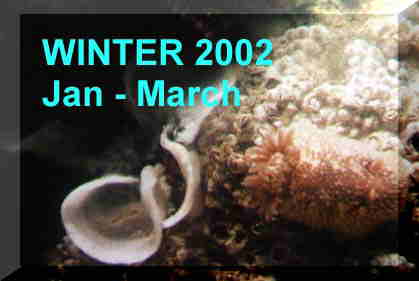 |
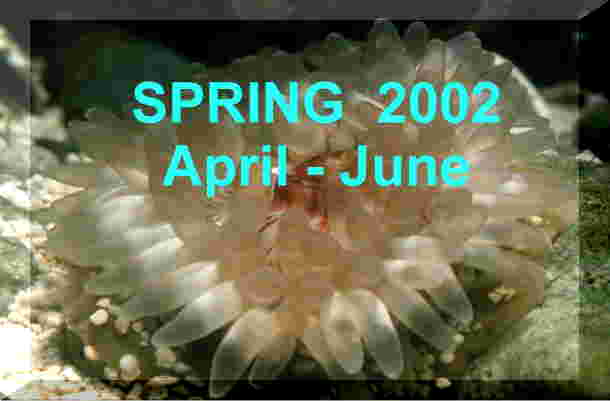 |
 |
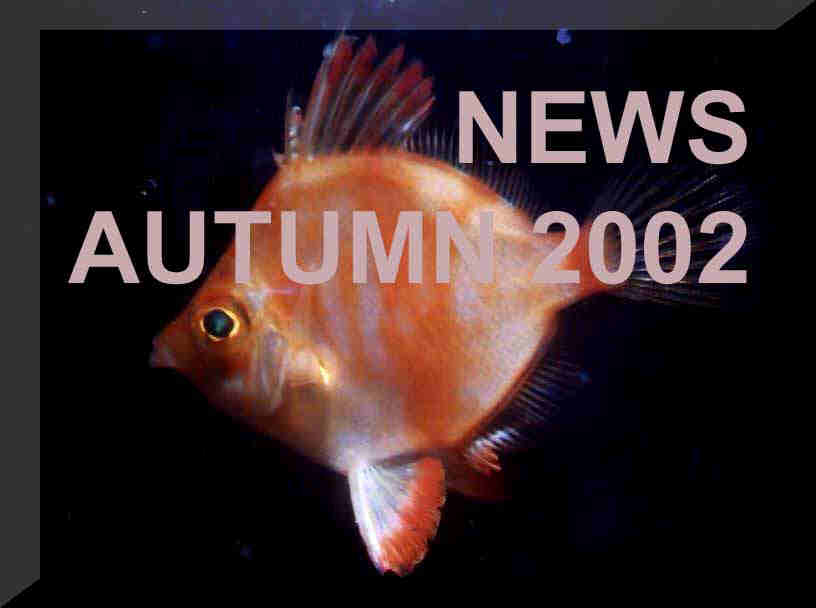 |
FOR EARLIER REPORTS CLICK ON THE BUTTON BELOW

The Marine Wildlife of the NE Atlantic Forum commences.
PLEASE JOIN

MARINE WILDLIFE of the NE ATLANTIC EFORUM PAGE (LINK TO)
News 2002
News 2001
News 2000
News 1999
|
Use these links if your are familiar with the scientific classifications of marine life |
The BMLSS (England) site commenced on 1 January 1997.
|
|
 |
 |
Andy Horton, Webmaster
|
|
|
|
|
|
Membership Form |
News 2001 News 2000 |
